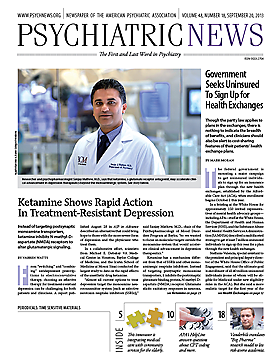Psychiatric factors do not appear to predict whether a homicide defendant used a firearm, killed multiple victims, or is convicted of the crime, a finding that would seem to counter the popular notion—prevalent in the wake of recent mass killings that have made the news—that perpetrators of mass gun violence are invariably mentally ill.
The finding is from a study appearing in the September American Journal of Psychiatry that assessed the association between homicide and a wide range of demographic and clinical variables.
“It is notable that clinical variables, such as Axis I diagnoses, were not associated with offense characteristics or case outcomes when demographic and historical characteristics of the cases were included in the models,” wrote lead author Edward Mulvey, Ph.D., of the University of Pittsburgh Medical Center, and colleagues. “In particular, while age and race were significantly related to the use of a firearm, the addition of clinical variables to demographic and historical variables did not improve model fit. Furthermore, a model including demographic/historical and clinical variables did not significantly predict a guilty verdict, suggesting that case-specific factors were more salient in these determinations.”
In the study, defendants charged with homicide in a U.S. urban county between 2001 and 2005 received a psychiatric evaluation after arrest. Demographic, historical, and psychiatric variables as well as offense characteristics and legal outcomes were described. The researchers examined differences by age group and by race; they also looked at predictors of having multiple victims, firearm use, guilty plea, and guilty verdict.
Fifty-eight percent of the sample had at least one Axis I or II diagnosis using DSM-IV criteria, most often a substance use disorder (47 percent). Axis I or II diagnoses were more common (78 percent) among defendants over age 40. Although 37 percent of the sample had prior psychiatric treatment, only 8 percent of the defendants with diagnosed Axis I disorders had outpatient treatment during the three months preceding the homicide.
That suggests limited opportunities for prevention by mental health providers, Mulvey and colleagues said. “The rate of previous treatment observed in this sample raises issues relevant to mental health policy,” they wrote. “Although 53 percent of the sample were diagnosed with an Axis I diagnosis (including substance use disorders), less than half of these individuals had ever been hospitalized. Also, among those with an Axis I diagnosis, only 8 percent had received any treatment in the three months preceding the homicide offense. Moreover, this low frequency of recent psychiatric treatment differed markedly by race….Widespread disparities in access to care and cultural differences regarding help seeking are likely explanations for this difference. The low rate of treatment in the months preceding the offense, however, highlights the need for enhanced engagement of high-risk individuals (especially during times of emotional crisis) if mental health care providers expect to have an impact on serious violence.”
Steven Hoge, M.D., chair of APA’s Council on Psychiatry and Law, reviewed the report. “Individuals with an Axis I disorder were overrepresented among homicide defendants,” he told Psychiatric News, “but this was due to the high rate of substance use disorders found. The relationship between substance use and serious criminal behavior is well established. The study identified only 15 individuals—just 5 percent of the sample—who had a mental disorder and no co-occurring substance use disorder. Identification and treatment of substance use disorders are important not only to alleviate individual suffering, but also to improve public safety.
“The study findings address current concerns regarding gun use and mass killings by those with mental illnesses,” he continued. “There is widespread belief that mental illness is an important cause of firearm violence and mass murder. In fact, the researchers found no relationship between the presence of psychiatric disorders and the use of firearms. Nor did the presence of a psychiatric disorder relate to offenses involving multiple victims. These findings suggest that policies designed to keep firearms out of the hands of individuals with a history of mental illness will not prove to be effective as a targeted strategy.”
Hoge also said the study underscores the need for better access to psychiatric treatment, particularly substance use treatment. However, crime-prevention strategies that rely on psychiatrists’ reports are likely to be ineffective because most of this population is not in treatment or getting timely treatment. ■

